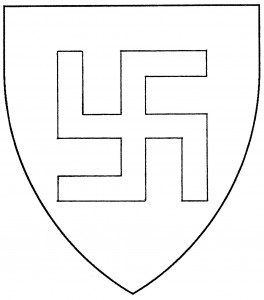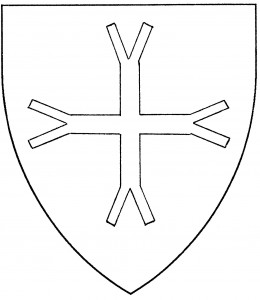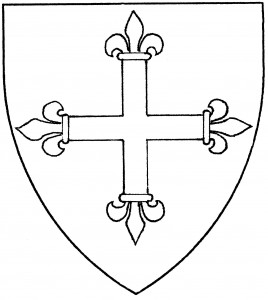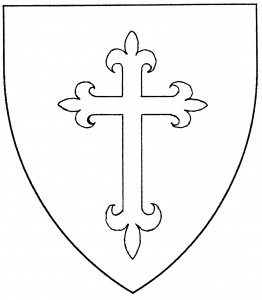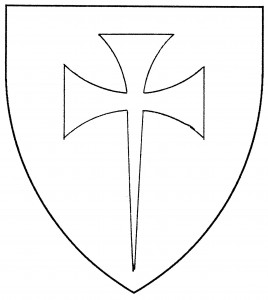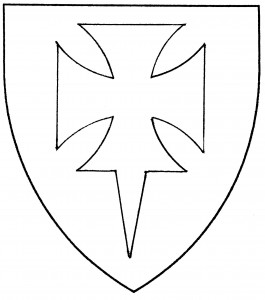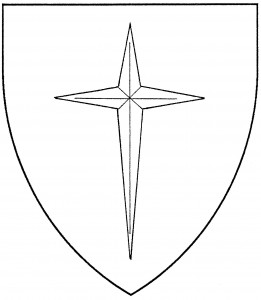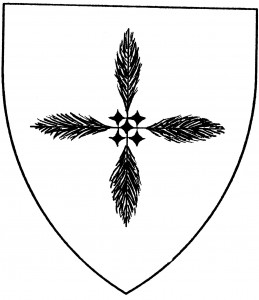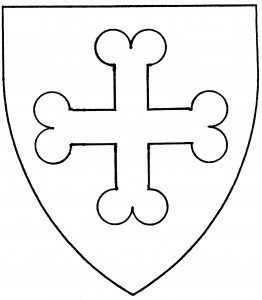The “fylfot” may also be blazoned a “cross gammadion” or a “cross potent rebated”. It’s found in the arms of Pedersson, 1442 [Raneke 581]; but as the symbol of the Nazi Party, it is deemed unacceptable for Society use.
Archives
Cross: Fourchy
The “cross fourchy” or “cross forchy” (literally “forked”) dates from c.1255, in the arms of de Vale [Asp2 155]; it was blazoned crois furche but was drawn either as in the illustration or as a cross moline. It is therefore considered only an artistic variant of the latter.
Zygmunt Nadratowski bears: Per pale argent and gules, a cross fourchy between the tines of each fork a roundel sable.
Cross: Fourchetty
The “cross fourchetty” (French fourchette, “wishbone”) is a Continental charge, found in the arms of van Damme, c.1370 [Gelre 91]. Unlike the cross fourchy, it is not considered an artistic variant of the cross moline, but a separate form of cross.
Crispin MacCoy bears: Argent, a cross fourchetty and on a chief sable an eye argent irised azure.
Cross: Formy
The “cross formy” was drawn with concave sides, as in the illustration, from c.1280 (in the arms of Ekont [ANA2 315]) throughout the Society’s period. Beginning in the 16th Century, it was also sometimes drawn with straight sides. The arms may converge to a single point at the artist’s discretion; the splay of the arms should be pronounced.
Dorothea of Caer-Myrddin bears: Argent, a cross formy sable.
Edmund Cavendish bears: Per bend azure and gules, a cross formy Or.
Domnall na nAmus bears: Vert, three crosses formy Or.
Cross: Flory, fleury, floretty, Cleves
The “cross flory” or “cross fleury” was originally an artistic variant of the cross patonce. As a distinct form, it dates from c.1300, in the arms of Lamplow [ANA2 314]. The distinction may be granted for the sake of the artist, but no heraldic difference is granted.
The “cross floretty” is a further outgrowth of the cross flory, with the fleurs-de-lys issuant from the ends of a cross couped. It’s a period variant, found in the arms of Carlisle, c.1455 [Scots 49v]. The cross floretty’s limbs may be straight, or splayed as a “cross formy floretty” (or “cross formy flory at the ends”). The distinction between a cross floretty, cross flory, and cross patonce may be blazoned for the sake of the artist, but no heraldic difference is granted between them.
The “cross of Cleves” is said to be an alternative blazon for the “Latin cross flory”; however, Your Author has found no examples of the term’s use in blazon outside the Society.
Godfrey de Calverley bears: Sable, in saltire five crosses fleury Or.
Constanza Raffaella dall’Oriente bears: Vert semy-de-lys, a Latin cross floretty Or.
Paul Puissant bears: Sable, three crosses of Cleves argent, on a chief dovetailed Or three torteaux.
Cross: Fitchy, fitched, fitched at the foot
A cross “fitchy” is any cross whose lower limb has been replaced with a long point. The term derives from the French for “fixed (in the ground)”; the cross is stuck into the ground by its point. Such crosses fitchy date from the earliest heraldry, as in the arms of de Vesci, c.1244 [Asp2 215]. Some modern texts use the term synonymously with “pointed”, and talk of a “cross fitchy at all limbs”; but this is a misunderstanding of the term, and should not be used. Normally the upper limbs of a cross fitchy are also treated, in some other way (since they cannot readily be throughout); the bottom limb is typically somewhat longer than the other three, and comes to a tapering point. The illustration shows a cross formy fitchy.
A cross “fitchy at the foot” (or “fitched at the foot”) is an artistic variant of the cross fitchy, where the point does not replace the lower limb, but instead issues from its center. In period, the usage seems only to have been used with crosses with splayed limbs: e.g., the cross formy fitchy at the foot, as seen in the banner of the Kings of Aragon, c.1370 [Gelre 62v] (and in the illustration), or the cross potent fitchy at the foot, c.1340 [Zurich 18].
Launcelot de Westwood bears: Azure, a cross botonny fitchy Or.
Cathleen de Barre bears: Gules, three crosses crosslet fitchy Or.
Seth Williamson of Exeter bears: Lozengy purpure and Or, a cross formy fitchy argent.
Olafr the mercenary bears: Per pale argent and gules, two crosses formy fitchy at the foot counterchanged sable and Or.
Cross: Estoile
The “cross estoile” may also be termed a “mullet of four points elongated to base”. It’s a Victorian type of cross, found in Elvin’s Dictionary of Heraldry, 1889 [8:45]; Your Author knows of no examples of its use in period armory.
Eilonwy de Lyur bears: Azure, two flaunches ermine, overall a cross estoile argent.
Cross: Ermine spots
The “cross of four ermine spots” is found as a charge c.1460, in the arms of Hurston or Hurleston [RH; also Legh 36v]. It is sometimes blazoned a “cross erminée” in mundane heraldry; the former blazon should be used, however, to avoid confusion with a “cross ermine” (i.e., an ordinary tinctured of a fur).
Maurya Etain Sableswan bears: Argent, a cross of four ermine spots within a bordure sable.
Mariana Francisco bears: Per bend sinister azure and gules, in canton a cross of four ermine spots argent, a bordure Or.
Cross: Doubly pommeled
Cross: Crosslet
The “cross crosslet” is found as early as c.1280, in the arms of the Earls of Warwick [ANA2 408]. In medieval times, the cross crosslet (so blazoned) could be drawn either as shown, or in the form now termed the cross bottony; the two were considered equivalent emblazons, only artistically different. They are so considered in Society heraldry as well.
A field semy of crosses crosslet may be termed “crusily” or “crusilly”.
William Bekwith bears: Argent, in cross five crosses crosslet sable.
Thomas Langland bears: Per pale argent and sable, a cross crosslet counterchanged.
Griffin Crosthwait bears: Vert crusilly argent.
